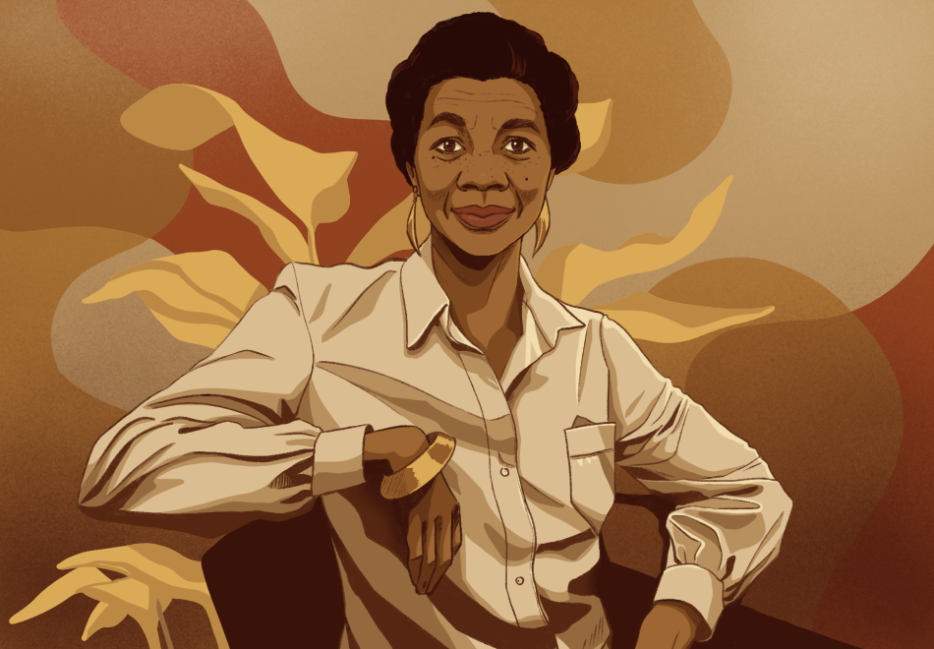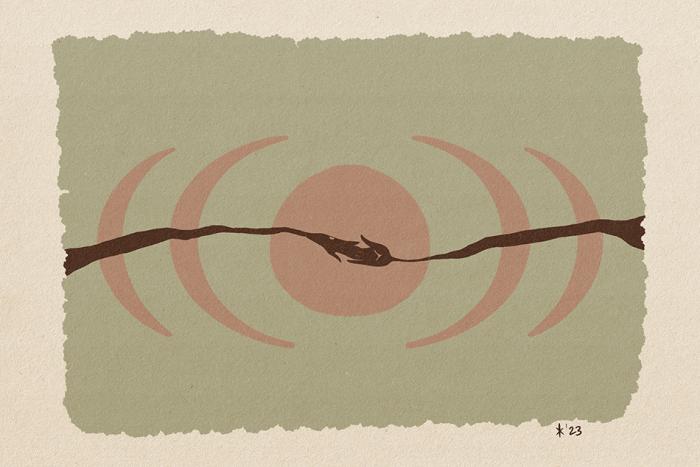A middle-aged Black woman sits in the reception area of a Los Angeles ER, weary yet serene. She’s waiting to be admitted, having sliced her hand on a rusty knife after breaking up a battle to the death between her two adult sons and, in so doing, pre-empting her family’s demise. Her heedful eyes meet those of a young Black girl in overalls and braids on the other side of the room. The elder woman inches forward, the cryptic, conspiratorial glint in her gentle gaze casting a brief enchantment in the midst of mortal crisis. For Charles Burnett, the writer-director of this exchange from his 1990 film To Sleep with Anger, the moment is one of reciprocal innocence, goodness recognizing goodness. But there is also a kind of understanding being telegraphed, across generations, of the woes and wickedness that Black women will be forced to wrestle with over the course of their lives. It is an understanding that dances across the face of the actress Mary Alice, who imparts a wry, winsome look to her younger scene partner. She is the face of continued survival, against all odds.
For every child of the eighties and nineties who came of age watching Black cinema, television, and theatre, there is a special place in the heart devoted to Mary Alice. “There was something about her that exuded warmth and kindness,” says the critic Aisha Harris. From the 1970s onward, Alice worked steadily on stage and screen, often in all-too-limited capacities. For certain viewers, Alice will always be Lettie, the senior dorm resident with a checkered past, during the first two seasons of A Different World. Others might recall her seven-episode stint as Regina Taylor’s dotty confidante on the NBC drama I’ll Fly Away, for which Alice earned an Emmy in 1993. For many, Alice is solely recognized as the Oracle in the second and third instalments of The Matrix, a role she assumed when her friend and colleague Gloria Foster passed away.
Some, like Harris, were introduced to Alice through the 1976 musical Sparkle, a cable TV staple. She plays the proud, hypercritical single mother of the three members of a rising girl group. In an indelible scene of this cult classic, Alice’s character warns her eldest daughter (Lonette McKee) about a drug-peddling partner, only to be met with protestations. “I know a rat when I see one,” she hisses in a stony whisper, unleashing a tempest of righteous judgment interwoven with parental concern. In Sparkle, Alice established the motherly archetype that she would perfect throughout her career, opposite scene partners as illustrious as Alfre Woodard (in Down in the Delta, the only feature directed by Maya Angelou) and Angela Bassett (in John Sayles’s Sunshine State). “Perhaps Mary Alice was typecast as a maternal figure,” Harris notes, “but she always played it so sweetly and graciously, and with a quiet authority.”
Despite these credits, it’s August Wilson’s landmark play Fences for which Mary Alice is destined to be remembered. The actress earned a Tony Award for creating the role of Rose, the self-sacrificing wife of baseball-star-turned-trash-collector Troy Maxson, from the play’s first workshop in 1983 through its Broadway premiere four years later. Acting opposite James Earl Jones, Alice provided the template later filled by Viola Davis on stage and screen. During the play’s emotional crescendo, Rose elucidates eighteen years of pent-up anguish and personal disappointments for her philandering husband, insisting, “I got a life, too.”
Wilson’s words could be understood as an accurate description of the frustrations of the artist who first uttered them. Even in the wake of her death in July 2022 at the age of eighty-five, the actress has seldom been discussed with the widespread ardour afforded the legacies of foremothers like Cicely Tyson and Ruby Dee. Alice’s career across mediums is more than deserving of reappraisal as a record of the overlooked pleasures, aches, and endeavours of everyday Black women, endowed here with intricate dimensions and a vitality too radiant to disregard.
*
Mary Alice was born in 1936 to Samuel and Ozelar Smith, Mississippians who soon moved the family to Chicago. They raised Alice and her four siblings in a house later razed to free up space for the neglected red-brick high-rises of the Cabrini-Green Homes. Samuel and Ozelar worked, respectively, in a laundry and a factory, all while maintaining a strict Baptist home. As Alice approached adulthood, she sought reputable, stable employment and found it as a third-grade teacher in the city’s public school system. But she was not long for the classroom.
Her introduction to acting was serendipitous: while shopping in the Loop during summer break, Alice was handed a flyer for a community theatre group that was holding auditions for a production of Lorraine Hansberry’s A Raisin in the Sun. Alice was intrigued and showed up at the open call, thinking it might be a fun way to while away the vacation. She was given a role—but turned it down upon actually reading Hansberry’s realist drama, cowed by the challenge.
But Alice was still drawn to the theatre and began to work part-time as a secretary for the community group. When she was offered a role as Big Mama in an all-Black cast of Tennessee Williams’s Cat on a Hot Tin Roof, she took it. Untrained and far too young for her matronly part, Alice remembered, “All I had to carry me through it was enthusiasm.” Her first professional role came to her when Douglas Turner Ward, a director, playwright, and ardent advocate of theatre by and for Black Americans, brought his still-fledgling Negro Ensemble Company to Chicago in 1966. Actors’ Equity required the New York–based company to use one local actor in its productions. That actor was Alice, who earned extra income by washing and ironing her fellow cast members’ laundry twice a week.
In these years, acting evolved from a distraction to a calling, a form of creation that could absorb and invigorate Alice but also serve its own pedagogic function. Decades later, Alice recalled her mother’s confession that she had dreamed of becoming a nurse, but that marriage and maternity had dashed the ambition, a disclosure that reinforced her daughter’s commitment to acting. Though Alice never married or had children of her own, her characters were frequently the kinds of Black American mothers, helpmeets, and caregivers diminished by Hollywood and pathologized as inadequate and emasculating by Daniel Patrick Moynihan in his infamous 1965 report on Black poverty in the United States. Alice grew up around women like these in Chicago’s West Side—her Aunt Mary, for instance, raised eleven children on her own. Her namesake “was strong and loyal in her love and a good person,” Alice told the Chicago Tribune in 1986. “A lot of Aunt Mary is in me.” Alice folded her observations of these women into her roles, giving her characters depths of thought and emotion seldom plumbed in mass entertainment. She came to see acting as “my service in life. I’m supposed to use it.”
Alice quit teaching, dropped her surname, and made her way to New York the following year, auditioning, attending classes, and living off her savings from teaching. She wasn’t accepted as a member of the Negro Ensemble Company but instead admitted into its advanced acting course, taught by Lloyd Richards, a Canadian-American artist and educator who would go on to become dean of the Yale School of Drama—and change Alice’s life in more ways than one. Alice’s training with Richards prepared her for parts in numerous productions of works by Black dramatists such as Adrienne Kennedy, Charles Gordone, Ntozake Shange, and Phillip Hayes Dean. Alice cherished the latter’s The Sty of the Blind Pig, which provided her with “the greatest role I’ve ever been privileged to play,” that of a repressed Chicago spinster awakened by a blind, singing vagabond.
A still-unknown Alice has an auspicious, scene-stealing cameo in a 1971 New York Times profile of the director Gilbert Moses, in which her real tears during an audition stun Moses and his collaborators into silence. (She got the part.) But it was only when she won a 1979 Obie Award for her turns in Athol Fugard’s Nongogo and a Public Theater production of Julius Caesar that Alice found her footing as a performer. “That was when I finally accepted the fact I was an actress,” she recounted that same year. “Before that, I always needed someone else to assure me that was true.”
“Her style was so laid-back, so honest, so pure,” says actor Frankie Faison, a fellow veteran of the Negro Ensemble Company, who counts his first time watching Alice on stage as “a defining moment” in his acting education. The younger Faison was further taken under the actress’s wing when the two appeared together during the original run of Fences. They remained lifelong friends. “She was a technician in a way, but her technique was so connected to who she was as a person that you would never, ever see technique come into play when you watch Mary Alice work or when you work with her,” says Faison. Courtney B. Vance, who originated the role of Rose’s son Cory in Fences, says that Alice looked after him throughout the play’s various iterations, during early rehearsals where the cast spent weeks sitting around a table with Richards, sharing stories from their lives. According to Vance, “Mary Alice was the glue in the family” that was the company of Fences. For the young actor, Alice was a guiding light. “She was that divine mixture,” Vance remembers. “[She] could master the actual drama, the pathos [of a text], and go deep into it… She taught me, through love, how to be.”
In February, I visited the New York Public Library’s Theatre on Film and Tape Archive to watch Richards’s storied production of Fences. James Earl Jones, booming and barrel-chested, dominates the play, but it is Alice, so often positioned upstage, who keeps drawing attention. Sometimes she does this with an affirmative mhm, a doubtful uh-huh, or a chiding Troy, all utterances of a woman who seems—but only seems—desensitized to her husband’s tantrums and tall tales, having spent years calling his bluffs and bringing him down to earth with unbothered matter-of-factness. She can be quick with her hands when the men in her life get too fresh or disobedient, but Alice mostly lies in wait throughout the play. The actress is a humming and hypnotic presence even in the midst of domestic drudgery, attentive to all but concealing her worries and suspicions, save for a slanted brow or a weighty pause. As in all of her performances, Alice demands that we watch closely and carefully, turning our gaze towards the fringes of a scene as she primes us for the emotional land mines and stark truths to come.
When Troy confesses to his wife that he has fathered a child with another woman, Fences pivots around Rose’s show-stopping lament. That this scene has become an iconic moment in the history of American theatre is a testament to the actress who first gave Wilson’s prose a pulse. Here, Alice is a woman trudging through the battlefield that is now her marriage, realizing she is less a person to her spouse than another burden breaking his back. At one point, the petite Alice repeatedly socks her towering scene partner square in the torso; though Alice at first demurred from hitting Jones, she performed these gut punches eight times a week with a strength that never failed to rock audiences—and still stuns, even when glimpsed on a computer monitor more than thirty years later. Alice bears down on Jones until she achieves a catharsis without relief, an excavation of the soul.
The run of Fences proved demanding for Alice for other reasons: her father passed away in April 1987, a day after Wilson’s opus won the Pulitzer, and her mother followed in November. The character resided close to home for the actress, calling on her lineage and upbringing. “Sometimes you just feel an affinity; you immediately know who a person is,” Alice told the Times of her most acclaimed stage character, whom Alice based on the women who reared and resided alongside her in Chicago. “They put up with a lot of indignities and humiliations because they were women and were attached to men, and their life outside the house was very limited.” In Alice’s performance, Rose’s bruised pride coexists with the depths of her devotion. In the few moments when Rose puts her foot down, Alice punctuates the tongue-lashing with a sweet giggle or a tender sigh that suggest an affection knotted with resentment, contradictory feelings that cannot be explained by language alone.
The actress brought the same soulfulness to her finest film role in To Sleep with Anger. Alice’s Suzie is a professional midwife and the stalwart head of a South Central family bedevilled by Danny Glover’s Southern caller, a friend from her family’s long-ago past. To Sleep with Anger marked the first time that Charles Burnett worked with a cast of established actors, an intimidating endeavour that Alice assuaged for the director, teaching him to think deeply about his characters’ motivations and temperaments. Burnett told me that working with Alice was the sort of experience “that spoils you for anything else that comes along.”
Delicately braiding fear, solicitude, and pluckiness, Alice makes her divine earth mother an ideal foil to Glover’s diabolical spirit. The character is enshrouded in a benevolent mystique that can only be attributed to Alice’s trademark self-possession, her unclouded gravitas. Burnett remembers that Alice’s reserved performance didn’t immediately register on set, only in dailies where her seamless “being of the character” exerted a riveting power. “She reached a level that pieced the film together,” Burnett says. “It’s all Mary Alice in a way.”
And yet To Sleep with Anger failed to augur more occasions for Alice to make a deeper mark on the big screen. When Spike Lee needed someone to make a cameo as a schoolteacher in the galvanizing finale of Malcolm X, he chose Alice, the onetime educator who radiated worldliness and seemed uniquely capable of opening minds in a theatre or a classroom. But Alice’s late career ultimately followed the trajectory of too many actresses of colour: stock parts, limited screen time, waning demand, and, finally, routine neglect that ends the moment they are taken from us. Alice did not shy away from speaking out against the disappointing and unimaginative opportunities proffered to her and her contemporaries. As she said in a 2002 interview, “Most of the time [these characters are] pretty much the strong Black woman: nurturing, taking care of people but nobody’s taking care of her because she doesn’t need care because she’s so strong.” In the same interview, she said, “There’s no role I’ve ever played where there’s been a character as complex as I am, as a person is, as a woman is.”
One can easily comprehend why Alice treasured her part in The Sty of the Blind Pig, whose 1971 off-Broadway production was reworked and filmed for a Los Angeles PBS affiliate. (It aired in 1974.) As Alberta, the emotionally arrested daughter of a God-fearing mother, Alice at one point falls into an ecstatic, psychosexual hallucination, summoning a level of expressive physicality and psychological precarity that is too often regarded as the sole province of Method titans. Lunging her body with abandon, propelling herself towards bottomless abysses of agony and ardour, Alice exerts a galvanic intensity that one can barely believe found a place on prime-time TV, rendering her character’s nihilistic eruption with flesh, blood, and fire. It is the type of explosive, once-in-a-lifetime performance that only an actress with supreme control of her instrument can deliver.
Though there were rarely occasions for thorny, nuanced characterizations, Alice remained fervently committed to her career until her retirement in 2005. “It’s all about the work,” she told Essence in 1987. “Anything else can be taken away from you.” Alice brought this professionalism to each and every undertaking, the better to become one with her characters. There are times where she suggests a sense of self so hidden as to be untouchable, in the way that all of us possess ideas, aspirations, and whole worlds that we are unable or unwilling to share even with those closest to us. Her finest performances are enticements that playfully tease the possibility of better knowing a particular character—but always and only on Mary Alice’s terms. Look closer and one just might see the whirling minds and deeper beings of these women glimmer like a light under a door.
Upon her retirement, Alice’s artistry was deeply missed, not least by collaborators like Faison. In the obscure years between her retirement and passing, he would beg her to return to the craft. “It had become too difficult to do the job the way she wanted to do it,” Faison recalls, noting that the gruelling schedule of eight shows a week and the physical demands of touring ruled out any additional stage work. She told her protégé that she was content passing her days at home or spending time with loved ones. Up until her last visit with Faison, not long before her death, Alice would tease him with a running joke that originated from their days making theatre history in Fences. “‘Frankie, I taught you everything you know,’” Faison remembers Alice telling him. “‘You can’t do anything without me. You need me out there.’”
Vance tells me that Alice battled bouts of depression, but that there was also never a birthday of his where she failed to call and sing to him in a deep belt. “Everything was family [for her],” he says. He visited whenever he was in New York and brought her to services at Brooklyn’s Christian Cultural Center for spiritual uplift. Vance chokes up when he reminisces about taking Alice to see Hamilton and watching the show’s young cast pose for photos with the long-retired actress.
Acting, for Alice, was a vocation rooted in care for her characters, whose dramatized lives could be a medium through which to explore and illuminate long-ignored experiences. As she told Contemporary Theatre, Film & Television in 1989, “I chose this profession because I feel this is how I can fulfill my service as a human being—communicating the human condition.” There are multitudes beneath Alice’s graceful composure and the loving caress of her voice, multitudes she conveyed with fine-grained finesse and ample consideration of the real and imagined Black women for whom she was at once vessel and outlet. She gave expression to their dreams, vulnerabilities, and endurance. Her presence—whether witnessed for hours or minutes—was a proclamation that, as long as she appears, attention and respect will be paid to them. Perhaps Faison puts it best when he tells me, “With Mary Alice, the lessons can continue.”






